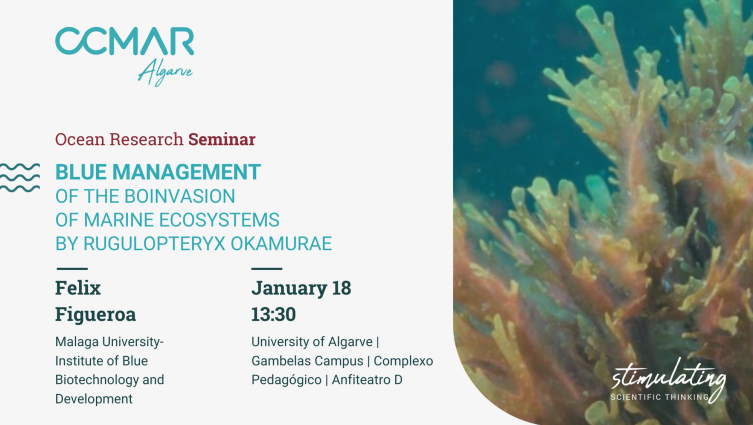Blue management of the boinvasion of marine ecosystems by Rugulopteryx okamurae
Rugulopteryx okamurae is a brown algae (Ochrophyta) from the Dyctiotacea family, that initiated bioinvasion in 2016 in the coast of Strait of Gibraltar, displacing native species and provoking economic losses in the fishing and tourism sector. This species have invaded also Portugal coasts (Algarve , Azores Island) and France (Marseille). R. okamurae can grow from surface to 40 m depth in hard substrates and when it is detached from the substrate, they can remain long period under water and transported to other area moved by the water currents. Finally, high amount of biomass can be deposited in the coast (Beach cast algae). The algae is submitted to different environmental conditions affecting biochemical composition. In addition, seasonal variations in bioactive compounds is expected. In this study, the seasonal content of pigments (Chlorophyll and carotenoids), soluble proteins, lipids , soluble, carbohydrates , fucoidans and polyphenols has bene analysed in submerged algae, both fixed in the substrate and detached, and emerged algae (beach cast algae). Antioxidant capacity by using ABTS and DPPH methods was also determined. In general, the levels of bioactive compounds are maintained similar through the year in the three type of samples i.e Soluble carbohydrateas (150-200 mg g-1DW) and lipids (80-100 mg g-1DW). The level of polyphenols (4-10 mg g-1DW) and soluble Proteins (1-5 mg g-1 DW) were low compared to other brown algae. Fucoidans ranged from 60 to 80 mg g-1 DW. Only attached algae in surface waters (0.5-1 m) presented decreased in the content of Fucoidans is summer period . Total carbon ranged from 32 to 39 mg g-1 DW and total nitrogen from 1.7 to 4.5 mg g-1 DW. Chemical diversity was studied by using spectrophotometric methods and Fourier transform ion cyclotron mass spectroscopy (FT-ICR-MS). A total of 3042 molecular formulas were identified from the different extracts. R. okamurae was rich in carbonated compounds (total carbon, lipids, CHO, and CHOP). R. okamurae, molecules with a great number of pharmaceutical activities (e.g., anti-inflammatory or antitumoral), antibacterial, biomaterial, and other utilities were found. The biotechnological valorization focused to the industrial uses of this species can help to counteract the environmental effects of the bioinvasion reducing the economical and social impacts.
The seminar will be held on January 18, at 13:30, at the University of Algarve, Gambelas Campus - Complexo Pedagógico, Anfiteatro D, and also online, via Zoom.
Participation is free but mandatory to register.
About our speaker:
Professor of Malaga University. Director of the Institute of Blue Biotechnology and Developemnt (IBYDA). Publication of 288 papers on ecophysiology , Photobiology and biotechnology of algae , 24 Thesis conducted. Hindex: 47
This seminar was kindly sponsored by



